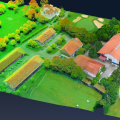
Chris Grundy of the London School of Hygiene and Tropical Medicine led a project to estimate the population of Am Timan in Chad using satellite images. This is the first time that a human population has been estimated from space, and has the potential to speed up medical and disaster relief efforts.
Until now, groups like Medecins Sans Frontieres (MSF) have had to rely on the 'quadrat' method to estimate population size. Surveyors visit a sample of individual households to find out how many people live in each type of dwelling. From this, they estimate the population of the entire town or refugee camp. But the method is slow, as it demands teams of up to a dozen samplers, and requires careful data analysis afterwards. Also, such operations can be hazardous or impossible to carry out in conflict zones such as Syria.
Preliminary results presented in London at the annual research meeting of MSF revealed that the satellite method matched the accuracy of the quadrat method, but took half the time. Grundy claims that, with refinement, it has the potential to be much faster.
The established quadrat method, which required sampling visits to 1160 dwellings, gave a population of 49,722. The satellite technique, which required sampling visits to only 348 dwellings, gave estimates of 46,625 for the manual and 45,400 for the automated method.







